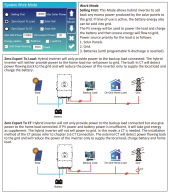I tried to search but not much showed up. "export from battery" turned up a lot of "zero export" results, which is opposite of what I need.
I'm about to install PV panels and a hybrid inverter. I already have about 50 kWh worth of cells. With night-to-day price difference skyrocketing here, buying cheap electricity at night to store in batteries and export during peak daytime hours would significantly offset the cost of/amortize a PV installation.
Which hybrid inverters available in 2022 can do:
I'm about to install PV panels and a hybrid inverter. I already have about 50 kWh worth of cells. With night-to-day price difference skyrocketing here, buying cheap electricity at night to store in batteries and export during peak daytime hours would significantly offset the cost of/amortize a PV installation.
Which hybrid inverters available in 2022 can do:
- Battery charging from grid.
- Export from battery to grid.
- Prioritize solar input between grid export and battery charging.
- Externally controllable. (If the inverter doesn't know the hourly prices and tariffs for import and export costs or if I can't control it without manually clicking in some app, it simply can't do what I need it to do)



